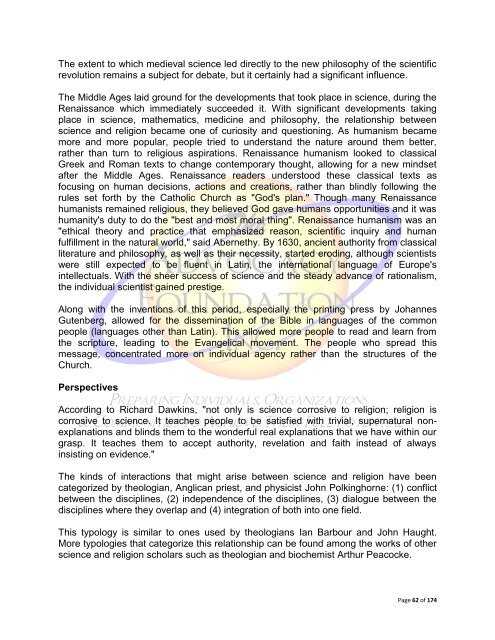The Gift of Spirituality
The Gift of Spirituality
The Gift of Spirituality
Create successful ePaper yourself
Turn your PDF publications into a flip-book with our unique Google optimized e-Paper software.
<strong>The</strong> extent to which medieval science led directly to the new philosophy <strong>of</strong> the scientific<br />
revolution remains a subject for debate, but it certainly had a significant influence.<br />
<strong>The</strong> Middle Ages laid ground for the developments that took place in science, during the<br />
Renaissance which immediately succeeded it. With significant developments taking<br />
place in science, mathematics, medicine and philosophy, the relationship between<br />
science and religion became one <strong>of</strong> curiosity and questioning. As humanism became<br />
more and more popular, people tried to understand the nature around them better,<br />
rather than turn to religious aspirations. Renaissance humanism looked to classical<br />
Greek and Roman texts to change contemporary thought, allowing for a new mindset<br />
after the Middle Ages. Renaissance readers understood these classical texts as<br />
focusing on human decisions, actions and creations, rather than blindly following the<br />
rules set forth by the Catholic Church as "God's plan." Though many Renaissance<br />
humanists remained religious, they believed God gave humans opportunities and it was<br />
humanity's duty to do the "best and most moral thing". Renaissance humanism was an<br />
"ethical theory and practice that emphasized reason, scientific inquiry and human<br />
fulfillment in the natural world," said Abernethy. By 1630, ancient authority from classical<br />
literature and philosophy, as well as their necessity, started eroding, although scientists<br />
were still expected to be fluent in Latin, the international language <strong>of</strong> Europe's<br />
intellectuals. With the sheer success <strong>of</strong> science and the steady advance <strong>of</strong> rationalism,<br />
the individual scientist gained prestige.<br />
Along with the inventions <strong>of</strong> this period, especially the printing press by Johannes<br />
Gutenberg, allowed for the dissemination <strong>of</strong> the Bible in languages <strong>of</strong> the common<br />
people (languages other than Latin). This allowed more people to read and learn from<br />
the scripture, leading to the Evangelical movement. <strong>The</strong> people who spread this<br />
message, concentrated more on individual agency rather than the structures <strong>of</strong> the<br />
Church.<br />
Perspectives<br />
According to Richard Dawkins, "not only is science corrosive to religion; religion is<br />
corrosive to science. It teaches people to be satisfied with trivial, supernatural nonexplanations<br />
and blinds them to the wonderful real explanations that we have within our<br />
grasp. It teaches them to accept authority, revelation and faith instead <strong>of</strong> always<br />
insisting on evidence."<br />
<strong>The</strong> kinds <strong>of</strong> interactions that might arise between science and religion have been<br />
categorized by theologian, Anglican priest, and physicist John Polkinghorne: (1) conflict<br />
between the disciplines, (2) independence <strong>of</strong> the disciplines, (3) dialogue between the<br />
disciplines where they overlap and (4) integration <strong>of</strong> both into one field.<br />
This typology is similar to ones used by theologians Ian Barbour and John Haught.<br />
More typologies that categorize this relationship can be found among the works <strong>of</strong> other<br />
science and religion scholars such as theologian and biochemist Arthur Peacocke.<br />
Page 62 <strong>of</strong> 174

















